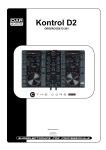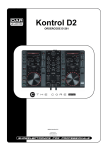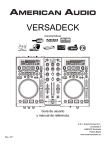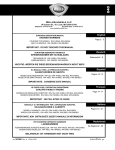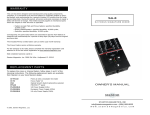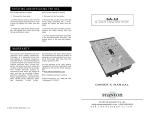Download Stanton SA-5 Turntable User Manual
Transcript
SA-5 The Official Mixer of The Allies All-star Beatdown OWNER’S M A N U A L STANTON MAGNETICS, INC [email protected] www.STANTONDJ.com © 2003, Stanton Magnetics, Inc. WELCOME! WA R R A N T Y Thank you for making Stanton your first choice in professional DJ mixers. This innovative mixer has been developed with input from the professional DJ community, bringing to the marketplace a previously unavailable, affordable combination of user-friendly, functional design, rugged construction, and professional quality features. This unit has been designed and manufactured using quality components. Therefore, it is warranted to be free from defects in materials (limited as specified below), and workmanship for a period of twelve (12) months from the original purchase date. During this period, all service and parts necessary to repair a defect will be free of charge. This limited warranty applies to mechanical parts which are subject to wear and tear as specified: Stanton and your authorized Stanton dealer are dedicated to your complete satisfaction by offering benchmark service and support throughout the long life of your Stanton product. • Faders (except P&G faders), specified durability: 15,000 cycles; • Rotary potentiometer, specified durability: 10,000 cycles; • Switches, specified durability: 10,000 cycles. We appreciate your patronage, and look forward to many years of making music together. PL E A S E RE A D C A R E F UL LY B E F O R E U SE FAI LU R E TO F O LLO W TH E I N S TR U C TI O N S PR I N TE D B E LO W M AY V O I D WAR R AN TY • Follow all security advice printed on your mixer. Consequently, the parts listed above are warranted to be free from defects in materials and workmanship for a period of thirty (30) days from the original purchase date. The included Penny & Giles faders carry a twelve (12) month warranty. For the warranty to be valid, please complete the warranty registration card attached or fill out the online registration at www.STANTONDJ.com Mail completed warranty cards to: Stanton Magnetics, Inc, 3000 SW 42nd St., Hollywood, FL. 33312 • When removing the unit's AC plug from the power source, grasp and pull the plug, NEVER the cord itself! • Avoid placing your mixer near heat sources, such as power amplifiers. • When in use, place your mixer on a stable surface, away from vibration. Always use care when carrying your mixer. Impact, or heavy vibration may compromise the unit's mechanical integrity. The manufacturer is not responsible for damage resulting from an impact, or misuse. • When in use, place your mixer away from sources of hum or noise, such as transformers, or electric motors. • To prevent overheating, always provide your mixer with adequate ventilation air space. • Avoid stepping on your mixer's AC cord. Repeated compression of the cord may lead to electrical shorting. • To avoid damage due to AC voltage peaks, always disconnect your mixer from the power source during electrical storms. If possible connect mixer to a surge protector. • Your mixer contains no user-serviceable parts. The manufacturer is not responsible for any damage or personal injury resulting from unauthorized user-servicing or modifications. In addition, the warranty will be void if and unauthorized service by the user is detected. Always return your mixer to an authorized Stanton dealer for servicing. SUPERIOR SOUND TECHNOLOGY The audio quality of the SA-5 is nothing short of revolutionary for DJ mixers in it’s price class. The SA-5 was designed by Stanton’s new product development team, seasoned audio professionals who have designed world class professional recording studio and broadcast mixers and product managers who are working DJs and work closely with some of the world’s most respected DJs. They have taken their knowledge and experience to create the SA-5, a DJ mixer with superior audio quality and unprecedented value. Come hear the difference! S A - 5 F E AT U R E S T E C H N I C A L S P E C I F I C AT I O N S Line input: 2 (RCA) x 2 channels, -10 dBV / 10 kOhm Session Input: 2 (RCA), -10 dBV / 10 kOhm Phono input: 2 (RCA) x 2 channels, -50 dBV / 47 kOhm Mic input: 1(1/4") -50 dBV / 2.4 kOhm balanced Master output: 2 (1/4”) Balanced / 2 (RCA) unbalanced, The SA-5 “The Official Mixer Of The Allies All-Star Beatdown” Introducing the world’s first all fader battle mixer. Designed by Stanton based on DJ Infamous’ requirements, the SA-5 is a high-end, affordable mixer with all the requirements of today’s top turntablist. The simplicity of the layout is sure to make the SA-5 the preferred mixer for the battle circuit. +4 dBu balanced / -10 dBV unbalanced Record output: 2 (RCA), -10 dBV / < 100 Ohms Headphone output: 2 (1/4 inch), 1 (1/8 inch) Features include: • Only mixer in the world with all faders (no rotary knobs) Greater than 32 Ohm load Frequency Response (Line): 20 Hz to 20 kHz +/-1 dB THD+N: < 0.015 % at 1 kHz Signal to Noise Ratio (ref: max level): > 110 dB (main signal path) Noise: < -92 dBV (Line input to any output) Channel EQ: Hi +9, -45 dB, (Kill) Mid +9, -35 dB, (Kill) Low +9, -55 dB, (Kill) Crosstalk: < -90 dB at 1 kHz Channel and Crossfader Kill: < -100 dB Dimension (LxWxD): 17.5 in x 14.2 in x 4.3 in Weight: • OS II optical phono/line switches (for "noise-free" transforms) with lock feature • 3-way adjustable curve control on line faders & cross fader • Balanced Master output • 2 Phono, 2 Line, 1 switchable Mic / Session inputs • 3 position cue select switch (Pre CF / Post CF / Master). An all new concept in cueing: Post Fader Cue allows you to listen to your scratches in the headphone while using the crossfader as normal • Program reverse (44.5 cm x 36 cm x 11 cm) • Master output attenuation control 8.6 lbs (3.9 kg) • Phono input attenuation control R E P L A C E M E N T PA RT S To replace the cross or channel faders, follow steps 1 and 2 of the cleaning instructions. The following replacement parts are available from Stanton or your local Stanton dealer. CF-PG110 Penny & Giles crossfader/ line fader OS2 Optical Scratch Switch (phono/line selector) PS-16US US Power Supply (110v) PS-16EU European Power Supply (220v) PS-16UK UK only Power Supply (240v) • 3 headphone outputs (2 x 1/4” and 1 x 1/8” minijack) w/ headphone mute button • New screwless faceplate • Includes custom designed P&G (Penny & Giles) crossfader and line faders. • Unique recessed front panel design prevents DJ’s from accidentally damaging the headphone jack and the mixer during battling • An ergonomic layout for non-interrupted performance DESCRIPTION OF FUNCTIONS 2 3 FADER CLEANING AND REPLACEMENT 5. 4 6. Examine the center channel of the fader body (found inside the bottom of the fader casing) and if dirty, clean using cotton buds. Re-assemble and lubricate the fader as follows: a) Secure the end block and guide rail onto the fader body. b) Insert track into the fader body. 1 c) Insert slider assembly onto guide rail and into the fader body. Move 6 slider from end to end to disperse the oil evenly. Carefully wipe away any excess oil using a tissue or cloth. 5 8 7 10 9 12 d) Lubricate the guide rail by placing one drop of silicon liquid oil onto the guide rail (F). e) Insert dust cover. 14 11 7. 13 8. 15 15 16 18 Attach fader to fader plate. (NOTE: As noted earlier if you do not want to change positioning of fader, keep the 2 fader plate screws loose and shift the fader until it is aligned with the marks you created in step 1, then tighten fader plate screws.) REPLACING THE FADER: 1. Once the fader has been removed, simply plug the connector into the new fader. 2. 17 1. Session Level control: Controls the input level of the session or mic input, depending on setting of session/ Mic switch (27). 2. Gain: Controls the gain of each input channel. The sensitivity of the gain faders is adjusted by the phono trim (25) knob on the back of the mixer. 3. 4. 5. f) Insert fader track back into fader body with wires coming out open end of fader body. g) Secure the remaining end block ensuring that the track wires (I) are not pinched between the end block and fader casing. Once assembled, move the slider from end to end to ensure operation is smooth. Place fader back in mixer and replace 2 outer screws to secure fader. R O TAT I N G T H E O S 2 S W I T C H E S The optical scratch switches (OS2) on the Stanton SA-5 mixer can be rotated to 8 different positions. Follow the steps below to rotate the OS2 to the position you like: 1. Make sure the mixer is powered off. Remove the faceplate of the mixer. 2. Remove the two outer screws from the OS2 as indicated in diagram. Do not remove the two inner screws. Removing the two inner screws will detach the OS2 from its plate. Program Reverse: Reverses the signal of input channels 1 and 2. When switched down, channel 1 will control channel 2’s inputs. 3. Rotate the OS2 to the position you like. Replace the two outer screws to secure the OS2 in place. Master Volume control: Controls the overall signal output level of the mixer. The sensitivity of this fader is controlled by the master trim knob (21). REPLACING THE OS2: Line Fader Reverse: Reverses the direction of each respective line fader. When switched down, the channel will be at full volume when the fader is down. The volume will decrease as the fader is moved upward. 1. Follow steps 1 and 2 above. Remove switch from mixer and detach the connector from switch. 2. Attach the connector for OS2 to the replacement switch and replace two outer screws to secure the OS2 in place. FADER CLEANING AND REPLACEMENT After constant scratching, the SA-5 faders may need to be cleaned and lubricated from time to time. This will ensure long life and keep a smooth feeling throughout the fader's lifetime. Follow the instructions below to lubricate and clean your faders: MIXER FUNCTIONS 6. Crossfader Reverse: Reverses the direction of the crossfader. When switched down, channel 1 will be assigned to the right side of the crossfader, and channel 2 to the left side. 7. OS2 lock: Locks the OS2 in its current position to avoid accidentally switching sources. Whether the OS2 is in phono or line, activating the OS2 lock will keep it there even if the OS2 is moved. 8. Cue Level: Controls the headphone output level. 9. EQ: Individual controls for low frequency, midrange, and high frequency equalization with (+9dB/Kill) Note: Any changes made to EQ settings will change the overall output level. REMOVING A FADER: 1. 2. 3. 4. Make sure mixer is powered off and power supply is disconnected from the back of the mixer. To remove the lower faceplate, take off all the fader knobs and then remove the 4 screws located on the sides of the mixer (2 on each side). Lift up on the faceplate and it will slide off. Remove the fader to be cleaned or replaced by unscrewing the 2 outer screws on the fader plate (removing the 2 inner screws will detach the fader from the fader plate). Disconnect the fader from the mixer by removing the connector on the bottom of the fader. CLEANING A P&G FADER: 1. 2. 3. Remove 2 mounting screws from fader plate. Figure 1 (NOTE: The P&G fader is designed with floating mounting threads for precise mechanical centralizing of the fader. If you desire to keep your fader`s current mounting position we suggest that you make 2 marks on both ends of the fader on the fader plate to indicate the P&G fader position.) See Figure 1. Once fader is removed from the unit, remove the two screws (A) from the end of the fader body where the wires exit the fader casing. Pull away the end block. Withdraw the dust cover (B). Taking great care, remove the slider assembly (C), ensuring that the wiper contacts (D) are not damaged as this will affect the operation of the fader. Clean the slider assembly by gently wiping the wiper contacts and slider bearings (E) using a tissue or cotton bud. If the slider bearings are excessively worn, as indicated by excessive slider rocking, then contact Stanton for replacement. Remove the single upper screw C B on the opposite end block to remove the guide rail. Clean the F guide rail (F) with a tissue or E A cloth, removing all traces of dirt G and contamination. D 4. Remove the fader track (G) by slowly withdrawing from the unit. Place the fader track on a desk or working surface with black contacts facing upwards. If necessary, the track can be washed in warm water, wiped gently then dried thoroughly using a dry cloth. Use a lint free cloth or swab to wipe the tracks and check for marks along the track. (Note: Lint free cloth should be used to avoid dust and fibers being deposited on the track). If the track appears excessively worn, or if cleaning does not improve its operation, replacement may be necessary. 10. Cue Select: On this feature, PRE and POST refer to the crosfader. In "PRE" position, the signal of control selected by the Cue pan fader will be monitored (pre-line fader, pre-crossfader) as a stereo signal in the headphones. The “POST” position, is somewhat similar to the “PRE” position, except the signal is post crossfader (pre-line fader, postcrossfader), so if the cue pan fader is centered, the signal received in the headphone depends on the position of the crossfader. In "MASTER" position, the signal monitored will be pre-master volume (post-faders), meaning the signal will still be present in the headphone even if the Master volume control is turned down. 11. Optical Scratch Switches (OS2): Switches between the phono and line inputs. 12. Cue Pan: Fades the headphone output between channels 1 and 2, effectively allowing the user to preview a mix. See cue select (10). 13. Power Indicator: The illuminated Allstar Beatdown logo also doubles as the power indicator. 14. OS2 Lock Indicator: Indicates when the OS2 lock (7) is on . 15. Channel Fader: Controls the output level of each channel. 16. Input Level Meter: Monitors each channel’s input level. 17. Crossfader: Fades the overall mixer output between channels 1 and 2. 18. Headphone Mute: Mutes the headphones without having to move the headphone volume knob. BACK P ANEL B A C K PA N E L 28. Headphone output: Standard 1/4” headphone output connector. 22 23 25 26 25 26 27 20 28 29 19 29. Session/Mic switch: Used to assign the Session/Mic fader to either the Session input or the MIC input. 30. Microphone input: 1/4” connector for connecting a microphone. 31. Phono Inputs: Phono level inputs for channels 1 and 2. Do not plug line outputs into phono inputs. 32. Line inputs: Line level inputs for channels 1 and 2. 30 21 24 31 32 31 F R O N T PA N E L 32 19. AC IN: Input connection for the included power supply. 20. Power switch: Turns the mixer on or off. 21. Balanced Master output: TRS balanced (1/4”) connectors are typically used to connect to a P.A. mixer or an amplifier for live performances or a recording console for recording. 22. Unbalanced Master output: RCA connectors are typically used to connect to a home stereo or to another mixer with RCA inputs for practicing or team routines. Several SA-5’s, can be daisy chained from this output via the session input (25). 23. Master Trim: Controls the sensitivity of the Master output. Great when an additional boost or cut is needed. 24. REC: The record output is not affected by the Master volume control.It can be used to record to a computer, CD, MD, & tape recorder, even while the master volume is turned down. 25. Phono Trim: Used to adjust the gain of the phono pre-amp. Use this knob to control the sensitivity of the gain faders. 26. Ground connector: Connects to the turntable ground connector to eliminate electrical hum. Ground cables usually supplied with turntables. Some newer turntables such as the Stanton STR8-150 do not require a ground cable because they are grounded internally. 27. Session Input: This extra line level input is controlled by the session level fader (1) when the Session/Mic switch (27) is switched to session (the up position). It can be used as an extra line input or as a session input for team routines. 33 34 34 34 35 36 35 37 33. Headphone output: Standard 1/8” (mini jack) headphone output connector. 34. Reverse indicator LED’s: The LED’s indicate the status of the fader reverse functions. The respective LED lights up when a fader is reversed. 35. Line fader curve switch: Three-position switch selects between a sharp, mid and long fade for the corresponding line fader. 36. Cross fader curve switch: Three-position switch selects between a sharp, mid and long fade for the crossfader. 37. Headphone output: Standard 1/4” headphone output connector.






